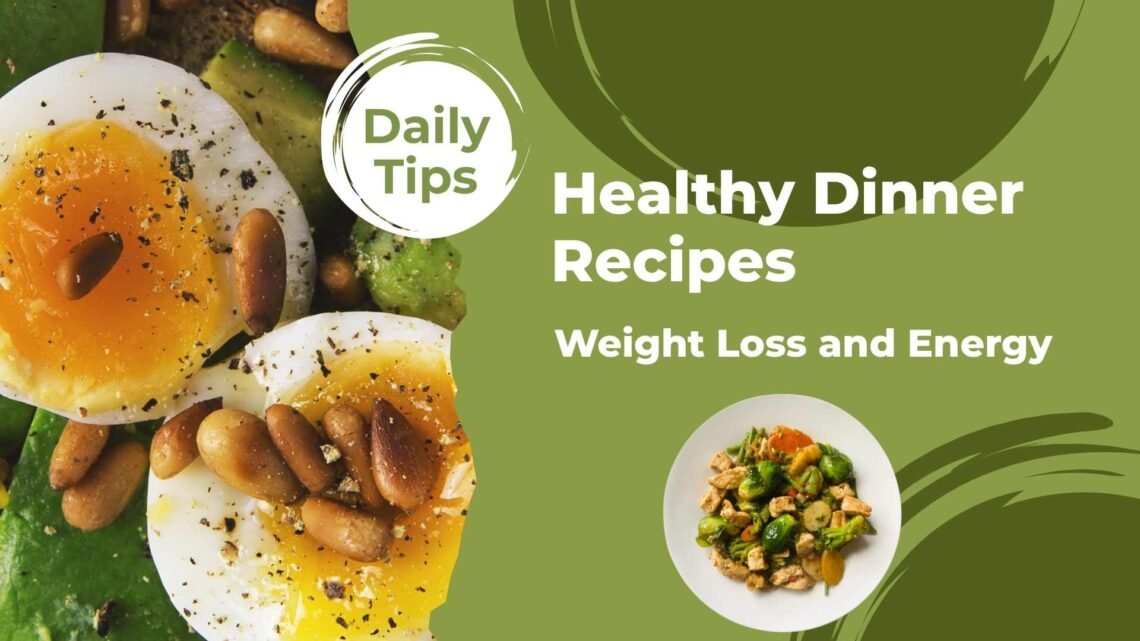Balanced healthy dinner recipes are essential to end your day on a nourishing note. Evening meals are your body’s final fuel before overnight fasting, so they should support metabolic balance, muscle recovery, and immune system repair. A well-crafted dinner aids cell regeneration and helps stabilize blood sugar levels overnight.
A satisfying dinner plate combines lean protein, whole grains, healthy fats, and colorful vegetables—aligning with dietitian-recommended proportions: around 50% vegetables, 25% protein, and 25% whole grains . Choosing nutrient-dense recipes like grilled salmon with steamed greens, bean-and-quinoa bowls, or vegetable-rich stir-fries can boost heart health, digestion, mood, and blood sugar stability .
Timing and portioning matter: a dinner eaten at least two hours before bed prevents indigestion and supports restful sleep while optimizing nutrient absorption . Planning healthy dinner recipes with simple cook-ahead methods, moderate calorie content (about 20% of daily intake), and diverse whole foods supports long-term well-being, weight management, and sustained energy into the next day
- Fills half your plate with vegetables and fruits to boost micronutrients and fiber
- Includes lean proteins and whole grains to support steady blood sugar and heart health
- Encourages cooking at home, which reduces calories, sodium, and unhealthy fats versus dining out
According to Unilever Health, nutrient-dense dinners improve mood, immunity, sleep quality, and gut-brain communication .
Top 8 Tips for Healthy Dinner Recipes
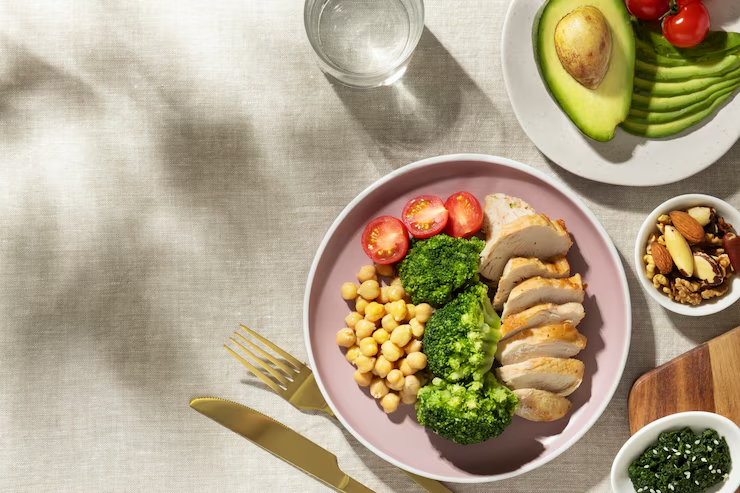
1. Build from the “Healthy Eating Plate”
Building nutritious healthy dinner recipes is simple with the balanced‑plate model: fill ~50% of your plate with vegetables and fruits, 25% with whole grains, and 25% with lean protein. This visual framework, endorsed by Harvard and Teladoc Health, ensures meals are rich in fiber, micronutrients, and steady energy.
For dinner, this could mean a colorful stir‑fry of mixed veggies, a whole‑grain base like quinoa or brown rice, and grilled fish or tofu. Keeping carbs whole and choosing lean proteins not only supports digestion and heart health but also helps stabilize evening blood sugar—a key element in effective healthy dinner recipes.
Adding a small portion of healthy fats—like olive oil drizzle, avocado slices, or a sprinkle of nuts—completes the meal. This balanced approach provides vitamins, minerals, protein, complex carbs, and beneficial fats in one plate, making it ideal for everyday healthy dinner recipes routines. Want some recipe ideas to match this plate structure?.
2. One-Pan & One-Pot Meals
Make dinner a breeze with one‑pan cooking! Sheet‑pan, skillet, and Instant Pot recipes combine convenience and nutrition for perfectly balanced healthy dinner recipes. A sheet‑pan salmon and broccoli meal delivers protein, omega‑3s, and fiber in under 30 minutes—plus easy cleanup.
Skillet dinners—like chickpea-and-vegetable skillets or chicken fajita bowls—are equally nutritious, offering at least 15 g of protein per serving and vibrant veggies in one dish . They require minimal prep, keep flavors bold, and limit dishes to a single pan—ideal for busy evenings.
Instant Pot recipes (soups, stews, grains) also make great healthy dinner recipes. Pressure cooking preserves nutrients, enhances digestibility in beans and grains, and provides set-and-forget convenience. Whether sheet‑pan, skillet, or Instant Pot, each method combines time-saving, minimal cleanup, and balanced nutrition—perfect for everyday healthy dinners!.
3. Plant-Based & Med-Style Focus
Incorporate plant-based proteins like legumes (beans, chickpeas, lentils) and tofu alongside colorful vegetables and heart-healthy extra virgin olive oil to create anti-inflammatory, flavorful healthy dinner recipes. These ingredients deliver fiber, protein, healthy fats, and antioxidants—key for reducing inflammation and supporting overall wellness.
A popular example is the Mediterranean chickpea-quinoa bowl: combining protein-rich quinoa, chickpeas, sautéed veggies, and a drizzle of olive oil or hummus. This recipe is nutrient-dense, satisfying, and easy to customize—perfect for batch prep or weeknight dinners.
Such healthy dinner recipes are also anti-inflammatory favorites in Blue Zones—regions known for longevity. Diets rich in legumes, whole grains, olive oil, and vegetables support digestive health, stable blood sugars, and reduced chronic disease risk .
4. High-Protein + Whole Grains (Healthy Dinner Recipes)
Boost your healthy dinner recipes by choosing meals with at least 15 g of protein and fiber-rich grains—like a quinoa‑lentil‑rice blend. This combo delivers a protein‑packed, nutritious base that supports satiety and energy balance for the evening .
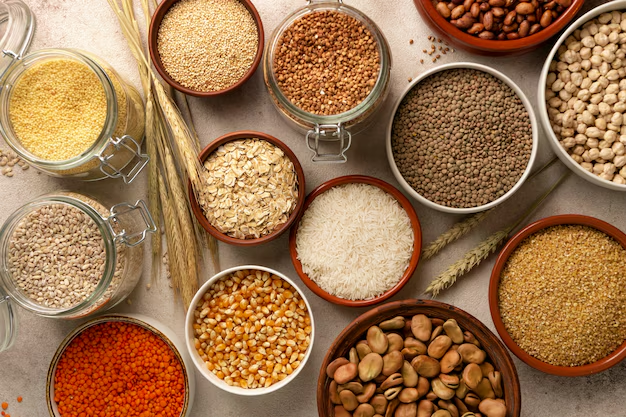
For example, combining half a cup each of lentils, quinoa, and white rice creates a meal that yields 44 g of protein and 30 g of fiber per batch—around 4.5 g fiber and 2 g protein per half‑cup serving—well above typical grain dishes. Lentils and quinoa both offer complete protein, making them ideal for plant-forward healthy dinner recipes .
Incorporating this grain‑legume duo into dinner options—like grain bowls, stuffed peppers, or stir‑ins—creates satisfying, nutrient‑dense healthy dinner recipes. They keep you full, help regulate blood sugar, and provide lasting energy with minimal effort. Try this simple, delicious upgrade tonight!
5. Prep Ahead & Batch Cook
Maximize busy weeknights by meal prepping cornerstone ingredients for healthy dinner recipes. Cook a batch of whole grains (like quinoa, brown rice, or farro), roast assorted vegetables, and pre-chop proteins (chicken, tofu, beans) or fresh herbs. This foundation saves time and ensures balanced meals.
Roasting veggies in bulk is simple—toss sweet potatoes, broccoli, carrots, or squash in olive oil, season lightly, and bake at ~200 °C (400 °F) for 20–30 minutes. Store in containers for easy access, slicing prep time midweek.
Armed with cooked grains, roasted veggies, and ready proteins or herbs, you can quickly assemble bowls, grain salads, stir‑fries, or sheet‑pan dinners. This meal‑prep method reduces decision fatigue, supports portion control, and encourages nutrient-dense healthy dinner recipes—making nutritious cooking both efficient and sustainable.
6. Use Seasonal & Commodity Staples
Embrace seasonal produce like tomatoes, zucchini, and corn to elevate your healthy dinner recipes. Seasonal fruits and vegetables are picked at peak ripeness, offering richer flavor, more vitamins, and antioxidants—all at lower prices than out-of-season varieties.
When fresh isn’t available, opt for frozen veggies and canned beans. Frozen vegetables are flash‑frozen at their nutritional prime—locking in fiber, vitamins, and minerals—while canned beans offer affordable, protein- and fiber-packed convenience. Just rinse low-sodium canned goods to reduce extra salt.
Combining seasonal fresh produce with pantry staples delivers healthy dinner recipes that are nutritious, budget-friendly, and easy to prepare. Enjoy roasted zucchini with olive oil, toss canned beans into soups, or add frozen corn to salads—delicious, wholesome meals made effortless and wallet-friendly.
7. Flavor with Herbs & Spices, Not Salt
Elevate your healthy dinner recipes by using flavorful spices like garlic, basil, cumin, turmeric, and za’atar. These herbs and seasonings enrich dishes with antioxidants and phytochemicals—boosting nutrient diversity and taste—without relying on added salt .
Each of these spices adds powerful health benefits: turmeric’s curcumin is a potent anti-inflammatory and antioxidant, while cumin supports metabolic balance and blood sugar control. Za’atar blends include polyphenols that nourish gut bacteria and reduce inflammation. Garlic and basil further support cardiovascular and cognitive health through their protective compounds.
When crafting healthy dinner recipes, sprinkle these spices liberally—on roasted vegetables, grain bowls, soups, or proteins. Not only does this boost flavor and aroma, it also increases nutrient richness while keeping sodium in check. Embrace spice-enhanced cooking to make meals both delicious and healthful!
8. Cook with Family or “Mealtime Rituals”
Sharing healthy dinner recipes and enjoying homemade evening meals with others encourages greater intake of fruits and vegetables. Studies show that people who frequently cook and dine at home eat significantly more produce than those who eat alone or dine out.
Regular shared meals also promote healthier eating habits and family bonding. Research indicates that participants in shared dinners have stronger dietary quality, including higher fruit–vegetable consumption, and benefit from improved routines and reduced reliance on processed foods.
Integrating communal cooking and dining into your week adds value to healthy dinner recipes. Whether it’s a vegetable-packed stir-fry, hearty bean chili, or colorful grain bowl, cooking and sharing these meals encourages better nutrition, connection, and consistent healthy habits around wholesome meals.
Recipe Inspiration
Quick Midi‑Week Meals (<30 min)
- One-Skillet Garlicky Salmon & Broccoli — protein + green veggie in one pan
- Chana Masala — spicy chickpea curry over brown rice; hearty, plant-based comfort
Fiber‑Boosted Add‑On
Comfort Classics Made Healthy
- Sweet-Potato & Chickpea Sheet-Pan Bake — roasted sweet potatoes, chickpeas, peppers; easy cleanup
- Caprese Chickpea Pasta Salad — cold, fresh, and protein-rich; perfect for hot evenings
Family-Friendly & Kid-Approved
- Minestrone Soup — beans, veggies, whole-grain pasta; comforting and nourishing
- Turkey Meatloaf with Veggies — classic comfort food, lightened up and wholesome
Meal Plan & Weekly Strategy
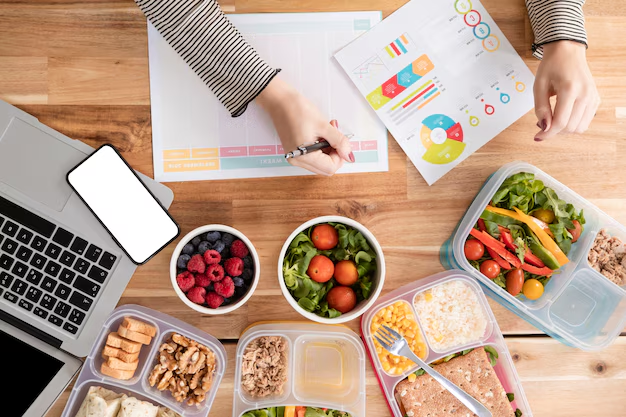
- Plan Ahead: use your grocery list to assemble veggie, grain, and protein staples.
- Batch Prep: Roast veggies, cook grains, hard-boil eggs.
- Mix & Match: Combine proteins and sides for dinners; double recipes for leftovers.
- Flavor Smartly: Use spices, citrus zest, homemade dressings.
- Monitor Nutrition: Implement Healthy Plate guidelines for each meal.
Benefits Recap
| Benefit | Details |
| Balanced nutrition | Vitamins, minerals, fiber |
| Stable energy | Protein + whole grains |
| Mental & gut health | Nutrient-dense, mood-regulating meals |
| Heart & metabolic health | Reduced saturated fat, sodium, refined carbs |
| Simplicity & sustainability | One-pan cooking, seasonal produce, less waste |
Conclusion
Healthy dinners don’t have to be time-consuming or overly complicated. With a few smart strategies, you can create nutritious, satisfying meals that nourish your body and taste amazing. Start by following the 8 key tips for healthy eating—such as using whole ingredients, prioritizing veggies, and controlling portion sizes. By applying the balanced plate rule (½ vegetables, ¼ lean protein, ¼ whole grains), you make sure your meals are full of nutrients while still being enjoyable. This approach keeps your energy levels steady, supports digestion, and helps with long-term weight management. When dinner becomes a balanced habit rather than a stressful task, it’s easier to stay on track.
Incorporating variety and simplicity is the secret to sustainable healthy dinners. Recipes like Mediterranean-inspired grain bowls, sheet-pan meals with roasted veggies and lean meats, and hearty salads topped with beans or grilled chicken are easy to make and delicious. These meals don’t require complicated cooking methods or expensive ingredients. With a little meal prep—like washing and chopping veggies ahead of time or pre-cooking grains—you can save valuable minutes during busy weeknights. Cooking with intention means you’re more mindful of what goes on your plate, leading to healthier choices overall.
Planning ahead is the true key to weeknight dinner success. By organizing your weekly menu and shopping accordingly, you eliminate the guesswork and avoid last-minute takeout. Whether you’re cooking for one, a partner, or an entire family, creating a go-to list of healthy dinners you enjoy will make it easier to stick to your goals. If you’re looking for inspiration, consider printable meal plans, grocery lists, or recipes tailored to your dietary needs—vegan, gluten-free, low-carb, or family-friendly options. Just say the word, and we’ll help you build a routine that turns healthy eating into an enjoyable lifestyle.
Healthy Dinner Recipes: Nourish Your Body, One Meal at a Time
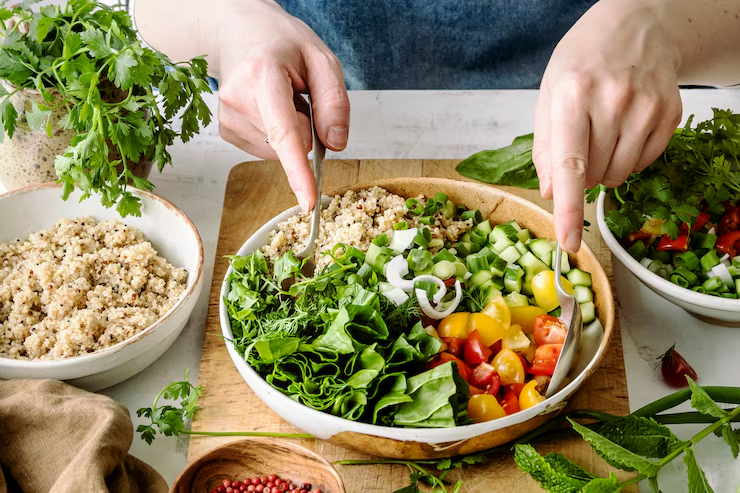
Eating a healthy dinner is one of the best ways to fuel your body and wind down your day with purpose. Whether you’re aiming to lose weight, improve energy, or simply eat better, nutritious dinners help you stay balanced without feeling deprived. The good news? Healthy dinner recipes don’t have to be boring or time-consuming. With the right ingredients and planning, you can prepare meals that are both delicious and good for you.
Start by building your dinner around whole foods—think fresh vegetables, whole grains, lean proteins, and healthy fats. Dishes like grilled chicken with quinoa and roasted vegetables, tofu stir-fry with brown rice, or a salmon and avocado salad are great choices. These meals are loaded with nutrients and flavor while keeping added sugars and processed foods to a minimum. For extra variety, explore global flavors—try Indian lentil curry, Mediterranean chickpea bowls, or Thai vegetable soup.
Batch cooking can make your weeknights easier. Prepare staples like brown rice, roasted sweet potatoes, and grilled proteins in advance, so you can mix and match during the week. Sheet-pan meals, one-pot dishes, and slow-cooker recipes also simplify cooking and cleanup. Try a chicken and vegetable sheet-pan bake or a lentil soup in the slow cooker—both are easy to make and full of fiber and protein.
For family-friendly options, make meals that are customizable. A DIY taco night with lean ground turkey, beans, lettuce, and salsa lets everyone build their plate their way. Or create a build-your-own grain bowl station with cooked rice, sautéed veggies, grilled proteins, and tasty sauces like tahini or pesto. These flexible meals encourage healthy choices without sacrificing taste.
Eating healthy dinners is not about perfection—it’s about balance. With a little creativity and preparation, you can enjoy meals that nourish your body and support your wellness goals. Keep experimenting, discover new recipes, and listen to your body’s needs. Healthy eating starts one meal at a time—and dinner is the perfect place to begin.
FAQ
1. What makes a dinner recipe “healthy”?
A healthy dinner includes a variety of nutrient-dense foods—vegetables, fruits, whole grains, lean protein, and healthy fats—while minimizing added sugar, saturated fat, and sodiu.
2. How do I build a balanced dinner plate?
Follow Harvard’s Healthy Eating Plate: 50% vegetables and fruits, 25% whole grains, and 25% healthy protein such as fish, beans, poultry, or legumes .
3. Are one‑pan or sheet‑pan meals effective for healthy cooking?
Yes! One-pan and sheet-pan dinners let you roast proteins and vegetables together with minimal cleanup, saving time while keeping meals wholesome.
4. Can plant-based dinners be satisfying and nutritious?
Absolutely. Beans, chickpeas, lentils, tofu, and high-protein grains like quinoa deliver filling, plant-powered dinners with fiber, protein, and micronutrients.
5. What’s a good approach to meal prepping healthy dinners?
Batch cooking staples—like grains, beans, roasted veggies, and cooked proteins—allows quick assembly of healthy dinners throughout the week .
6. How can I add flavor without excess salt or sugar?
Use herbs, spices, citrus juice, vinegars, and homemade sauces rather than relying on salt or processed ingredients .
7. Are high-protein dinner plans worth it?
Yes—meals with at least 15 g of protein (e.g., salmon, chicken, chickpeas) support satiety, muscle maintenance, and metabolic health.
8. Where can I find reliable healthy dinner recipe ideas?
Trusted sources include Mayo Clinic, EatingWell, Skinnytaste, and Nutrition.gov, which offer hundreds of recipes—like 40-minute dinners, skillet meals, Mediterranean bowls, and more .
Evening meals are your body’s final opportunity to nourish, support recovery, and prepare you for restful sleep. Choosing healthy dinner recipes isn’t just about what goes on your plate—it’s about timing, balance, and intentionality. Studies show that consistent meal timing and earlier dinners can reduce the risk of metabolic disorders and improve blood sugar control .
Crafting dinners that embrace whole vegetables, lean proteins, whole grains, and healthy fats—with flavor-driven herbs and spices—helps you avoid heavy, high-sodium takeout options . Cooking at home empowers you to control portions and ingredients, making nutritious meals more satisfying and aligned with your wellness goals .
Further, sitting down together for a homemade dinner enhances both nutritional intake and emotional well-being. Family or communal meals foster better eating habits—like consuming more fruits and vegetables—and build lasting connections . Ultimately, healthy dinner recipes are about creating balanced, flavorful meals that fuel your body, support health, and enrich life—one intentional plate at a time.
